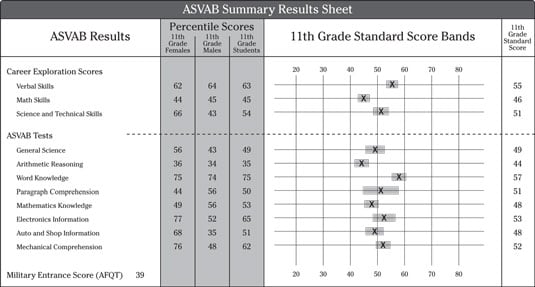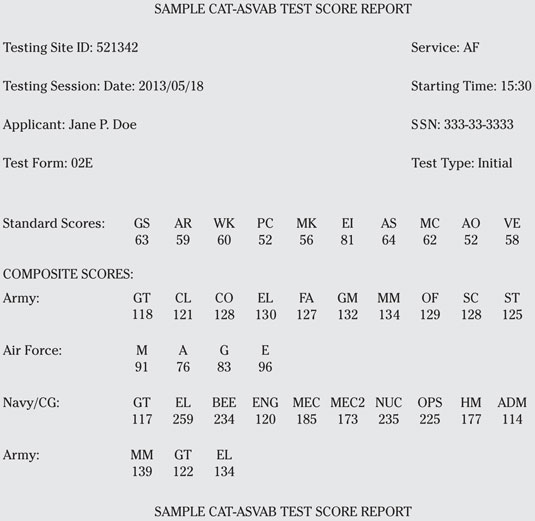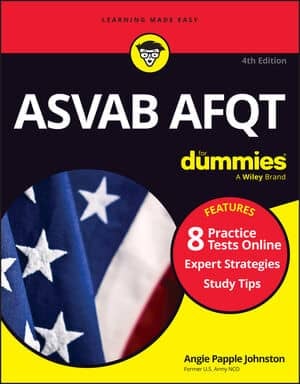 A sample ASVAB score card used by high school guidance counselors.
A sample ASVAB score card used by high school guidance counselors.The next figure depicts an example of an ASVAB score card used for military enlistment purposes.
 A sample ASVAB score card used for military enlistment purposes.
A sample ASVAB score card used for military enlistment purposes.So, what do all these different scores actually mean?
Defining all the scores
When you take a test in high school, you usually receive a score that’s pretty easy to understand — A, B, C, D, or F. (If you do really well, the teacher may even draw a smiley face on the top of the page.) If only your ASVAB scores were as easy to understand.In the following list, you see how your ASVAB test scores result in several different kinds of scores:
- Raw score: This score is the total number of points you receive on each subtest of the ASVAB. Although you don’t see your raw scores on the ASVAB score cards, they’re used to calculate the other scores.
You can’t use the practice tests in this book (or any other ASVAB study guide) to calculate your probable ASVAB score. ASVAB scores are calculated by using raw scores, and raw scores aren’t determined by adding the number of right or wrong answers. On the actual ASVAB, harder questions are worth more points than easier questions are.
- Standard scores: The various subtests of the ASVAB are reported on the score cards as standard scores. A standard score is calculated by converting your raw score based on a standard distribution of scores with a mean of 50 and a standard deviation of 10.
Don’t confuse a standard score with the graded-on-a-curve score you may have seen on school tests — where the scores range from 1 to 100 with the majority of students scoring between 70 and 100. With standard scores, the majority score is between 30 and 70. That means that a standard score of 50 is an average score and that a score of 60 is an above-average score.
- Percentile scores: These scores range from 1 to 99. They express how well you did in comparison with another group called the On the student version’s score card, the norm is fellow students in your same grade (except for the AFQT score).
On the enlistment and student score cards, the AFQT score is presented as a percentile with the score normed using the 1997 Profile of American Youth, a national probability sample of 18- to 23-year-olds who took the ASVAB in 1997. For example, if you receive a percentile score of 72, you can say you scored as well as or better than 72 out of 100 of the norm group who took the test. (And by the way, this statistic from 1997 isn’t a typo. The ASVAB was last “re-normed” in 2004, and the sample group used for the norm was those folks who took the test in 1997.)
- Composite scores (line scores): Composite scores are individually computed by each service branch. Each branch has its own particular system when compiling various standard scores into individual composite scores. These scores are used by the different branches to determine job qualifications.
The Big Four: Your AFQT Scores
The ASVAB doesn’t have an overall score. When you hear someone say, “I got an 80 on my ASVAB,” that person is talking about his or her percentile on the Armed Forces Qualification Test (AFQT) score, not an overall ASVAB score. The AFQT score determines whether you even qualify to enlist in the military, and only four of the subtests are used to compute it:- Word Knowledge (WK)
- Paragraph Comprehension (PC)
- Arithmetic Reasoning (AR)
- Mathematics Knowledge (MK)
Figure out which areas to focus on based on your career goals. If you’re not interested in a job that requires a great score on the Mechanical Comprehension subtest, you don’t need to invest a lot of time studying for it. As you’re preparing for the ASVAB, remember to plan your study time wisely. If you don’t need to worry about the Assembling Objects subtest, don’t bother with that chapter in this book. Spend the time on Word Knowledge or Arithmetic Reasoning. Keep in mind, though, if you don’t have a desired job or aren’t sure about your options, it’s best to study this book and take the practice tests, focusing on all areas of the ASVAB. Doing well on each subtest will broaden your available job choices and make you a more desirable candidate.
Calculating the AFQT score
The military brass (or at least its computers) determines your AFQT score through a very particular process:- Add the value of your Word Knowledge score to your Paragraph Comprehension score.
- Convert the result of Step 1 to a scaled score, ranging from 20 to 62. This score is known as your Verbal Expression or VE score.
- To get your raw AFQT score, double your VE score and then add your Arithmetic Reasoning (AR) score and your Mathematics Knowledge (MK) score to it. The basic equation looks like this: Raw AFQT Score = 2VE + AR + MK
- Convert your raw score to a percentile score, which basically compares your results to the results of thousands of other ASVAB test-takers. For example, a score of 50 means that you scored as well as or better than 50 percent of the individuals the military is comparing you to.
Looking at AFQT score requirements for enlistment
AFQT scores are grouped into five main categories based on the percentile score ranges in the following table. Category III is divided into subgroups because the services sometimes use this chart for internal tracking purposes, enlistment limits, and enlistment incentives. Based on your scores, the military decides how trainable you may be to perform jobs in the service.| Category | Percentile Score | Trainability |
| I | 93–99 | Outstanding |
| II | 65–92 | Excellent |
| III A | 50–64 | Above average |
| III B | 31–49 | Average |
| IV | 10–30 | Below average |
| V | 0–9 | Not trainable |
Depending on whether you have a high school diploma or a passing score on your state’s approved high school equivalency test (such as the GED), the military has different AFQT score requirements. Check out the following table.
AFQT Score Requirements
| Branch of Service | Minimum AFQT Score with High School Diploma | Minimum AFQT Score with High School Equivalency Test Certificate | Special Circumstances |
| Air Force | 36 | 60 | In very rare cases, if you possess special skills (such as speaking a foreign language that the Air Force considers critical), the minimum AFQT score can be waived. The Air Force allows less than 1 percent of its enlistees each year to have a high school equivalency test certificate instead of a high school diploma. |
| Army | 31 | 50 | The Army sometimes approves waivers for applicants with high school equivalency test certificates and AFQT scores below 31. |
| Coast Guard | 36 | Varies | If you have a high school equivalency certificate, the minimum AFQT score doesn’t apply. If your ASVAB line scores qualify you for a specific job and you’re willing to enlist in that job, the recruiter may be able to put in a waiver. Very few people (about 5 percent) each year are allowed to enlist with a high school equivalency certificate. |
| Marine Corps | 31 | 50 | You must have at least 15 college credits to enlist with a high school equivalency certificate. |
| Navy | 31 | 50 | If you enlist with a high school equivalency certificate, you must have 15 college credits. |
Checking out the military’s AFQT requirements for special programs
Achieving the minimum required AFQT score established by an individual branch gets your foot in the door, but the higher you score, the better. For example, if you need a medical or criminal history waiver in order to enlist, the military personnel who make those decisions are more likely to take a chance on you if they think you’re a pretty smart cookie than they would if you barely made the minimum qualifying score.Individual branches of the military tie many special enlistment programs to minimum AFQT scores:
- Army: The Army requires a minimum AFQT score of 50 to qualify for most of its incentive programs, such as a monetary enlistment bonus, the college-loan repayment program, and the Army College Fund.
- Marine Corps: Like the Army, the Marine Corps requires a minimum AFQT score of 50 for most of its incentive programs, including the Geographic Area of Choice Program, the Marine Corps College Fund, and enlistment bonuses.
- Navy: Applicants who want to participate in the Navy College Fund or college-loan repayment program need to achieve a minimum score of 50.
Enlistment programs are subject to change without notice based on the current recruiting needs of the service. Your recruiter can give you the most up-to-date information.
If you don’t know which kind of job you want to do in the military, the ASVAB helps you and the military determine your potential ability for different types of jobs. If you’re in this situation, review all the chapters in this book, brushing up on the basic principles of everything from science to electronics, but focus on the four subtests that enable you to qualify for enlistment: Word Knowledge, Paragraph Comprehension, Arithmetic Reasoning, and Mathematics Knowledge. Following this plan ensures a relatively accurate appraisal of your aptitude for various military jobs.

